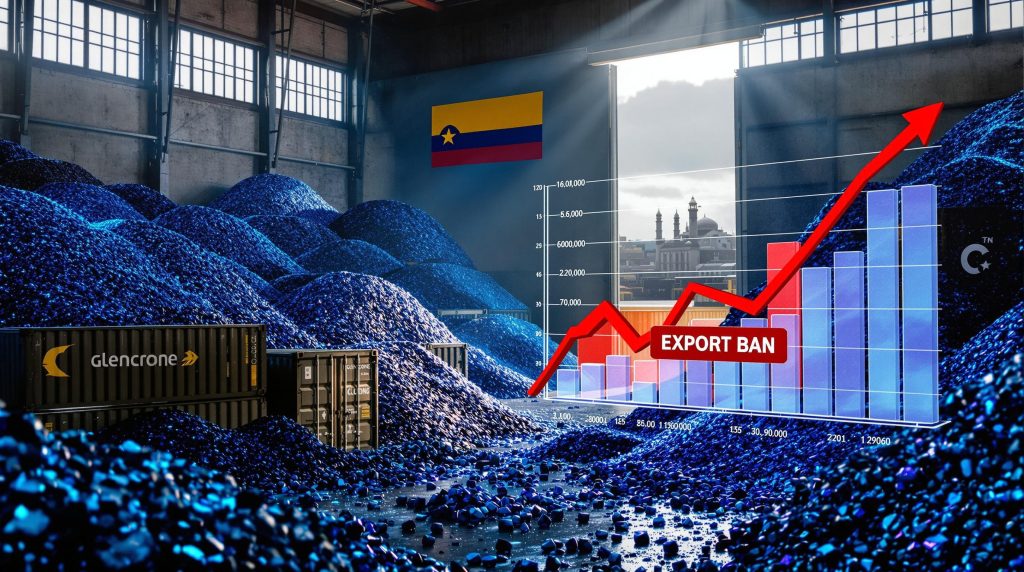Congo's Cobalt Export Ban: Glencore's Response and Market Implications
The Democratic Republic of Congo's decision to restrict cobalt exports has created significant ripples throughout global supply chains, with major mining companies like Glencore facing unprecedented challenges. As the world's second-largest cobalt producer navigates these restrictions, both immediate operational impacts and longer-term market implications are emerging for this critical battery metal.
What is Happening with Glencore's Cobalt Amid Congo's Export Ban?
Congo's cobalt export restrictions have forced Glencore into an unusual position of continuing production while facing severe limitations on sales. This situation has created a complex operational environment for one of the world's largest mining companies.
Congo's Export Restriction Timeline
The Democratic Republic of Congo implemented an initial four-month export ban on cobalt in February 2025, citing the need to address global oversupply issues that had driven prices to nine-year lows. In June 2025, authorities extended this ban for an additional three months, bringing the total restriction period to seven months and counting.
Congolese officials have used this time to develop a more structured approach to cobalt exports, working to establish a comprehensive quota distribution system. This regulatory framework aims to balance market stability with the country's economic interests as the dominant global producer of this strategic battery metal.
The ban represents an unprecedented market intervention by the Congolese government, designed specifically to address the price collapse that had undermined the profitability of mining operations throughout the country.
Glencore's Current Situation
Glencore now faces the prospect that a significant portion of its 2025 cobalt production will remain unsold by year-end. The company has already declared force majeure on certain cobalt deliveries from Congo, a legal provision that exempts it from contractual obligations due to circumstances beyond its control.
Since the ban's implementation, Glencore has been accumulating substantial cobalt inventory within Congo, creating logistical challenges but also positioning the company for potential market advantages when exports eventually resume.
According to Glencore CEO Gary Nagle, "No material financial effects were expected in the event cobalt sales did not occur for the remainder of the year, with any resumed volumes representing potential upside." This statement underscores the company's financial resilience despite the extraordinary market disruption.
The company's diversified business model has provided crucial protection against this single-commodity challenge, allowing continued operations despite sales limitations.
How is Glencore Managing Production Despite the Ban?
Despite export restrictions, Glencore has maintained robust production levels, demonstrating remarkable operational resilience in challenging circumstances.
Production Metrics and Forecasts
Glencore reported a substantial 19% year-on-year increase in cobalt output to 18,900 tons during the first half of 2025. This performance supports the company's full-year 2025 production forecast ranging between 42,000-45,000 tons, significantly higher than 2024's production of 38,200 tons.
These figures confirm Glencore's continued position as the world's second-largest cobalt producer, maintaining operational momentum despite market constraints. The production increase demonstrates the company's confidence in the long-term fundamentals of cobalt demand, particularly driven by electric vehicle battery production.
The Glencore operational adjustments showcase its operational flexibility and strategic long-term planning despite short-term market disruptions.
Strategic Inventory Management
Glencore has implemented a systematic approach to stockpiling cobalt within Congo's borders, creating significant inventories that will eventually reach international markets once restrictions ease.
The company has maintained a deliberately conservative planning approach regarding export resumption, refusing to incorporate speculative timelines into financial projections. When questioned by analysts, Glencore executives declined to specify exact quantities of stockpiled material, citing competitive considerations.
This strategic accumulation positions Glencore for potential market advantages when exports resume, with any permitted export volumes representing immediate upside to current financial projections. The inventory buildup also creates a buffer against potential production disruptions that might affect competitors when the market normalizes.
What Are the Market Implications of Congo's Export Ban?
Congo's export restrictions have profound implications for global cobalt production, creating supply uncertainties that ripple throughout industrial supply chains.
Supply-Demand Dynamics
The export ban has triggered a significant reduction in global cobalt availability, accelerating the depletion of worldwide inventories as manufacturers draw down existing stocks. This inventory reduction is expected to eventually provide price support for cobalt after reaching nine-year lows before the ban, according to a Reuters report.
The restriction creates particularly critical implications for electric vehicle battery production supply chains, which depend heavily on consistent cobalt supplies. As inventories tighten, manufacturers face increasing pressure to secure alternative sources or accelerate the adoption of cobalt-reduced battery chemistries.
Market analysts anticipate potential price volatility once exports resume, with initial volumes likely creating temporary oversupply before stabilizing at more sustainable levels under the quota system.
Global Cobalt Market Context
The Democratic Republic of Congo represents approximately 70% of global cobalt production, making its export policies extraordinarily influential for worldwide supply. This market concentration amplifies the impact of regulatory decisions made in Kinshasa.
The ban was specifically designed as a market intervention to address a severe price collapse that threatened the viability of mining operations throughout the country. Congo's approach demonstrates the increasing willingness of resource-rich nations to use export policies as tools for market management.
The quota system being developed aims to regulate future exports in a way that balances market stability with national economic interests. This approach may establish a precedent for how critical minerals transition is managed in producing nations in an era of increasing competition for battery metals.
How Does This Situation Impact the Broader Battery Metals Sector?
The cobalt export restrictions highlight broader vulnerabilities in battery metal supply chains, with implications extending well beyond immediate market disruptions.
Electric Vehicle Supply Chain Considerations
Despite ongoing efforts to reduce cobalt content, the metal remains an essential component in many electric vehicle battery chemistries, particularly those requiring higher energy density and thermal stability. The supply uncertainty created by Congo's export ban may accelerate industry interest in alternative battery technologies with reduced cobalt dependence.
Potential price volatility affects electric vehicle manufacturing cost projections, complicating planning for automakers already navigating complex supply chain transitions. This uncertainty comes at a critical juncture when EV manufacturers are scaling production to meet increasingly ambitious sales targets.
Automakers are likely reassessing supply security strategies, with potential approaches including:
- Direct investment in mining projects
- Long-term offtake agreements with producers outside Congo
- Accelerated development of cobalt-free battery technologies
- Increased battery recycling initiatives to recover cobalt from end-of-life products
Mining Company Responses
Other cobalt producers potentially benefit from restricted Congolese exports, particularly those operating in jurisdictions with stable regulatory environments. Operations in Australia, Canada, and Indonesia may see increased investor interest as diversification becomes a higher priority.
Mining companies across the sector are reassessing cobalt project expansion timelines, with some potentially accelerating plans to capitalize on market tightness while others adopt a more cautious approach until market signals become clearer.
The situation has increased focus on recycling and alternative sourcing strategies, with battery recycling technologies gaining additional investment as a hedge against primary supply disruptions. Strategic stockpiling is becoming more common industry practice as companies incorporate supply disruption risks into their operational models.
What is Glencore's Financial Outlook Amid These Challenges?
Despite export restrictions, Glencore has maintained a relatively stable financial outlook, leveraging its diversified business model to weather market disruptions.
Financial Impact Assessment
Glencore has publicly stated that no material financial effects are expected from unsold cobalt, even if sales do not resume in 2025. This confidence stems from the company's highly diversified business model, which provides substantial buffer against challenges in any single commodity segment.
The company has identified potential upside if export restrictions lift before year-end, positioning any resumed exports as bonus revenue beyond current projections. This conservative guidance approach has been well-received by investors seeking predictability amid market uncertainty.
Financial analysts note that cobalt represents a relatively small portion of Glencore's overall revenue mix, limiting exposure to this specific market disruption compared to more cobalt-focused mining operations.
Operational Adaptations
Glencore has demonstrated remarkable operational resilience by continuing production despite sales constraints, maintaining operational readiness for eventual market normalization. The company has worked to preserve customer relationships despite delivery interruptions, leveraging its global trading capabilities to provide alternative supply arrangements where possible.
The situation has reinforced Glencore's strategic positioning for eventual market recovery, with accumulated inventory potentially creating competitive advantages once exports resume. The company's global trading capabilities provide unique advantages in managing commodity risk, allowing more sophisticated responses to market disruptions than pure mining operators.
These adaptations showcase the value of Glencore's integrated business model, combining mining operations with trading expertise to navigate complex market disruptions more effectively than many competitors.
FAQs about Congo's Cobalt Export Ban
Why did Congo implement the export ban?
The Democratic Republic of Congo implemented the export ban in February 2025 after cobalt prices fell to nine-year lows. The ban aims to address global oversupply issues while giving authorities time to establish a quota system for distributing export permits among mining companies. This market intervention reflects Congo's increasing assertiveness in managing its natural resources to maximize national economic benefit.
How long will Congo's cobalt export ban last?
The initial ban was set for four months beginning in February 2025, but was extended by an additional three months in June. The total duration remains uncertain, with mining companies maintaining conservative assumptions about its potential timeline. The development of a comprehensive quota system will likely determine when and how exports resume.
What percentage of global cobalt comes from Congo?
The Democratic Republic of Congo dominates global cobalt production, accounting for approximately 70% of worldwide supply. This concentration makes the country's export policies particularly significant for global markets and creates inherent supply chain vulnerabilities for industries dependent on cobalt.
How does this situation affect electric vehicle manufacturers?
Electric vehicle manufacturers face potential supply chain disruptions and price volatility for a key battery component. This may accelerate interest in alternative battery chemistries with reduced or eliminated cobalt content while increasing focus on supply security strategies. The timing is particularly challenging as automakers scale up electric vehicle production to meet climate goals and consumer demand.
Future Outlook and Industry Implications
The cobalt export restrictions from Congo represent more than a temporary market disruption – they signal a fundamental shift in how critical mineral resources may be managed in the future. Resource-rich nations are increasingly recognizing their leverage in global supply chains, particularly for materials essential to energy transition technologies.
For mining companies, geographical diversification of operations becomes increasingly important as geopolitical mining trends gain prominence in investment decisions. The industry may see accelerated interest in cobalt projects outside Congo, even those with higher production costs that become economically viable in a more constrained market.
Battery technology development could see additional investment directed toward reducing or eliminating cobalt dependency, accelerating research into alternative chemistries. However, the technical challenges and performance trade-offs involved suggest cobalt will remain a critical component for premium applications requiring maximum energy density and safety.
The situation ultimately highlights the complex intersection of resource nationalism, supply chain security, and technological development that will continue shaping the battery metals sector for years to come. As the green energy transition accelerates, securing stable supplies of critical minerals will remain a strategic priority for manufacturers and governments alike.
Disclaimer: This article contains forward-looking statements and market analysis based on current information. Future developments may differ significantly from these projections due to regulatory changes, market conditions, technological developments, or other factors. Readers should conduct their own research before making investment or business decisions.
Ready to Stay Ahead in the Mining Investment Game?
Discover why major mineral discoveries lead to significant market returns by exploring the dedicated discoveries page at Discovery Alert, where the proprietary Discovery IQ model turns complex mining data into actionable insights for ASX investors seeking both short-term trading opportunities and long-term growth potential.




